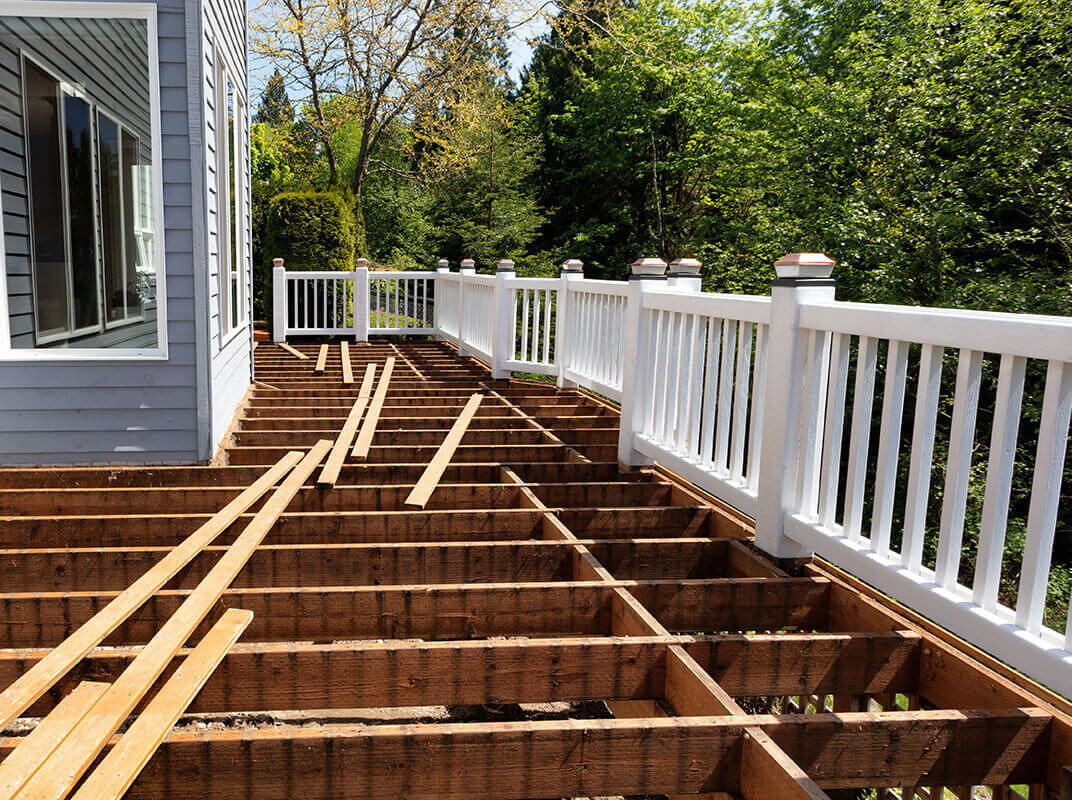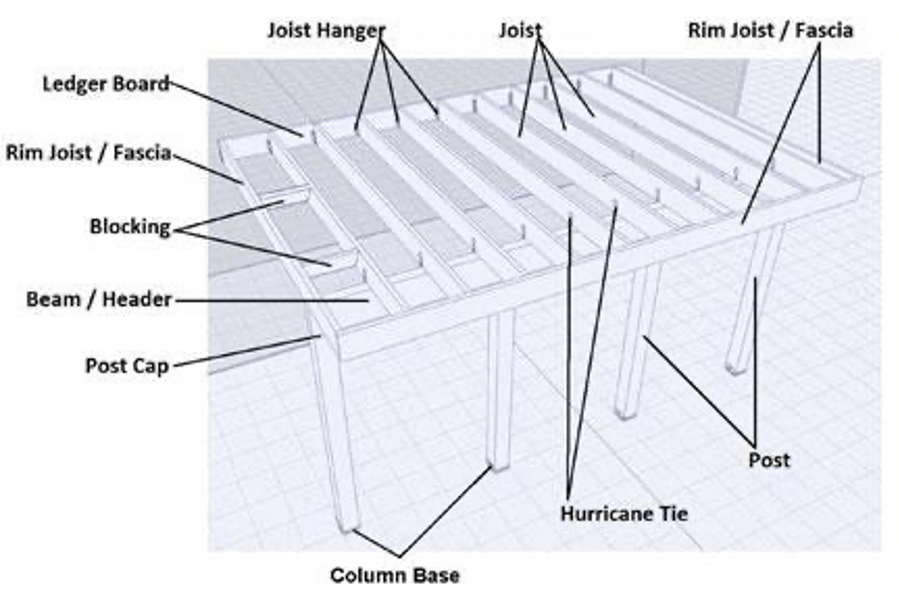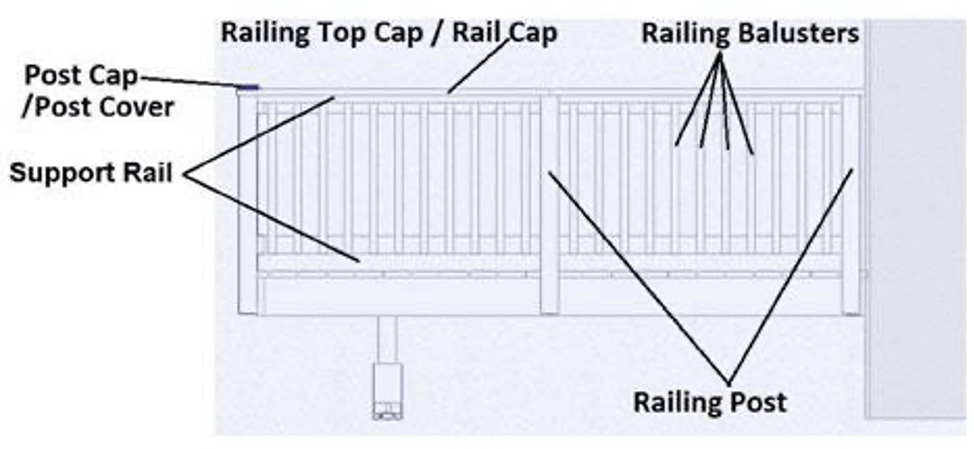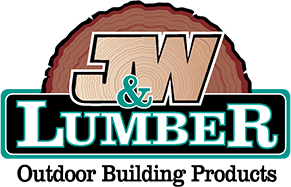
Decks may look simple when you’re standing on one, but there are many important components that go into every deck build. Decks are designed to support a significant amount of weight and last for many years, so they must be carefully constructed to ensure they are safe and sturdy.
The first step in understanding how all these pieces fit together is to get a firm grasp of the terminology. Here’s a quick list of the vocab you’ll need to start thinking and talking like a pro.
Below Deck: The Understructure
These are the terms for all the parts and pieces that make up the structural support for under the deck, or “understructure”. Although not visible from up top, the understructure of a deck is the first and most important step. The understructure must be sound in order for the deck to pass code inspection and remain safe even under pressure from gravity, sun, wind, and moisture.

Beam/Header – Sometimes referred to as the “beam” or “header,” this is the crosswise piece of lumber that is supported by the posts and in turn supports the joists.< Blocking/Bridging – These are small pieces of wood installed between perimeter joists to create more rigidity, adding to the structural integrity of the deck and preventing bounce.
Column or Post Base – This is a strong piece of specialized hardware that connects the post (column) to the cement footing sunk into the ground.
Joist – Long, sturdy structures that lay horizontally across the top of each beam. Joists create a strong, level surface to attach the decking boards. These may be made of pressure treated wood or steel.
Rim Joist or Band Joist – This is simply the outermost joist that runs around the perimeter of the deck. The rim joist fills the same function as other joists.
Fascia – This is a layer of material (wood or composite) that runs around the perimeter of the deck. Fascia is not structural. Instead, its main function is to conceal the understructure (joists and hardware) with more attractive material.
Hurricane Tie – Piece of structural hardware that connect joists to beams. Its purpose is to keep the joists in place.
Joist Hanger – Piece of hardware used when the deck will be attached to a house or structure that connects the joist to the ledger. Joist hangers are attached to the ledger board first and provide the support point for the joist.
Post – These are the thick pieces of lumber set vertically to support the deck framing. The correct number of posts is determined by the size and shape of the deck, as well as local building codes.
Post Cap – Hardware that connects the top of the post to the underside of the beam. Its purpose is to establish a strong connection between post and beam to resist uplift forces.
Sub-Structure/Understructure – The overarching term for the structural support holding up the deck. It’s always recommended to use pressure treated wood or metal that has been approved for outdoor use and ground contact.
Up Top: The Surface of the Deck
The surface of the deck is what you touch, walk on, and sit on. The materials you choose provide more aesthetic leeway. When deciding, make sure to use a material that is approved for decking and is sold from a reputable source like J&W Lumber. Never use pressure treated wood for the surface of your deck – the material is rougher, and the chemicals used in pressure treatment are not recommended for frequent contact.

Baluster – The thin rail components that fill in the space between posts to provide safety as well as visual appeal. The building codes for spacing between balusters can vary, so it’s important to check your building code before placing your balusters.
Decking/Deck Boards/Planks – The lumber that covers the surface of the deck, as well as the material you walk or sit on. California Redwood or composites like Trex decking are commonly-used materials.
Read More: Which Trex Decking Colors Should I Consider?
Post Cap/Post Cover – Attractive, sometimes ornately carved caps that cover the raw top of the railing post. May be made of wood, metal, or composite and can feature specialty design elements such as lighting or glass.
Railing – The guardrail that spans the perimeter of the deck. Meant to provide protection against people, objects, or pets falling off the deck’s edge.
Rail Cap/Railing Top Cap – The flat piece of wood or metal that sits on the top of the rail and runs the perimeter of the deck railing, giving it a finished look. Rail caps may be decorative or can serve a functional purpose, such as providing place to set drinks or plates.
Railing Post – The vertical posts that provide the structural support for the railing itself. Generally installed on the inside of the deck’s framing prior to adding the deck planks.
Now that you’re comfortable with decking terminology, it’s time to start planning to build or repair your own deck.
Call, email, or visit the team at your local J&W Lumber to discuss ideas, gather materials, and ask questions before you begin.

the blog is not bad, it has good information, but the wood sizes are missing.
For example, add 1×6 for cap
or 5/4 for deckboard etc..
4×4 post railing or 6×6 etc..